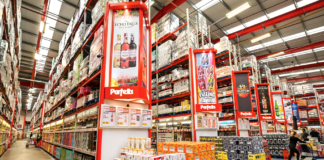Brexit and sugar concerns may have flattened chocolate sales, but Helena Drakakis finds that innovation is reaping rewards.
Chocolate, with its strong emotional connection, remains a firm favourite with the British public. However, the fall in the value of the pound and rising commodity prices, not to mention the ongoing debate around cutting sugar consumption, have put the category under pressure.
That said, the humble chocolate bar is still going strong, with manufacturers putting advertising spend behind many old favourites, while focusing efforts on developing exciting new products to reinvigorate a category that last year experienced flat volume sales.
Undoubtedly, ongoing uncertainties around Brexit and pricing will put further pressure on the category. But if wholesalers get chocolate – in both single and sharing formats – right for their retail customers, this stalwart impulse-buy will reap rewards.
“Wholesalers have an important role in servicing the growth of the convenience channel effectively, by offering strong availability, eyecatching displays and value for money,” says Bep Dhaliwal, trade communications manager for Mars UK’s chocolate division.
However, added to this mix is the increasing trend for premium chocolate treats, with consumers more interested than ever in provenance and unusual flavours and textures, meaning wholesalers need to keep track of the latest trends, too.
This article looks at those key trends in chocolate, while also examining the challenges faced by the industry.
Sharing is caring
Across the category, bitesize and sharing formats continue to perform well, as consumers favour treat bags and pouches.
According to Dan Newell, confections marketing manager at Wrigley, half the public are spending less money on out-of-home entertainment and as many are eating out less.
“The Big Night In is a key sales opportunity, as consumers are more conscious of their spending,” he says.
This ongoing trend is confirmed by Susan Nash, Mondelez trade communications manager, who says that both chocolate and candy sharing bags are growing in value. It’s one reason the company has invested in two new tablet variants this year: Cadbury Dairy Milk Oreo tablets in Mint and Peanut Butter flavours. Alongside these, Cadbury has launched Cadbury Fudge Minis.
“This launch aims to drive incremental sales for the family sharing occasion, particularly among young families spending a night in,” says Nash.
Mars UK’s Dhaliwal notes that sharing blocks grew by 2% across the category last year.
“Mars has been driving this growth with Mars’ sales up 0.3 percentage points to a 46.1% share of the category,” she says. “Mars UK has seven of the top 10 bitesize lines. Among those are Maltesers and M&Ms, both of which outperformed the chocolate category, recording a sales increase of 9.2%.”
Dhaliwal says this success was driven by the launch of two limited edition sharing packs last year. The first was M&Ms Mix, which saw M&Ms Chocolate, M&Ms Crispy and M&Ms Peanut combined into one sharing pack; the second was a summer-special, limited edition pack of M&Ms featuring only green, yellow and blue M&Ms.
Sharing formats aren’t just for the mainstream chocolate market. Plans are tightly under wraps, but luxury chocolate brand Doisy & Dam is looking to break into the premium sharing market later this year. Co-founder Ed Smith believes it’s an emerging market that hasn’t yet been fully tapped into.
Health and protein
The concern about sugar consumption has seen many manufacturers reformulating products and cutting portion sizes, particularly in single formats.
Indeed, government obesity guidelines call for a 20% reduction in sugar in products by 2020, and a report by Public Health England published this March suggested that if manufacturers couldn’t meet this target through reformulation then they should consider shrinking the size of individual bars.
One of many brands, including Mars UK, that have reformulated over the past few years is Nestlé. Its flagship brand KitKat has been relaunched with a reformulated recipe across its milk chocolate range, with each chocolate bar now containing extra milk and cocoa and featuring a flash on each pack communicating this to consumers. Following on from this is a reformulation of Nestlé’s iconic MilkyBar, with the percentage of milk in the new recipe increased from 26% to 38%.
The Health agenda has also led to a focus on adding extras such as protein. The sales of protein shakes and bars have soared 27% from £52m to £66m in two years, and to capitalise on this and following on from the launch of Mars and Snickers protein bars, a new Bounty protein bar with only 200 calories has been launched. This includes 19g of protein, which is about half the average UK adult’s recommended daily intake.
Michelle Frost, general manager for Mars Chocolate Drinks and Treats, says: “We were the first major confectionery brand to offer protein product alternatives in the UK,” she says. “We have not only seen sales soar through specialist channels, but also increasingly with impulse purchasers, who consume protein but enjoy the taste of their favourite confectionery brands on the go.”
Premium and provenance
According to analyst Mintel, premium chocolate is experiencing growth, with a 72% increase in products launched globally between 2011 and 2015. As consumers become more concerned with cocoa content, source of origin, uniqueness and authenticity, a quarter of chocolate buyers in the UK say they would pay more for a luxury brand of chocolate for themselves, while 44% would do so as a gift. Many consumers are now willing to trade up from Cadbury bars to brands such as Green & Black’s and then, when they’re in need of a special treat, go on to luxury brands such as Doisy & Dam, which combines indulgent chocolate with superfoods.
According to Doisy & Dam co-founder Ed Smith, premium chocolate is going from strength to strength. The company is now turning over £1m a year, four years after its launch, with blends such as Coconut & Lucuma and Goji & Orange a core part of the brand’s portfolio.
“We set out to make chocolate that was better for you in every way – better because the bars don’t include any nasties and because we put superfoods in them to create more interesting flavours and textures and give them a better nutritional profile. All that follows a general trend that we are seeing,” he says.
Doisy & Dam has been concentrating its efforts on working with wholesalers where initial traction is favourable – for example, wholesalers that focus on organic, health and independent stores, such as Epicurium, Marigold, Suma and Tree of Life: “Wholesalers have to see that there are many more people doing this and we’ve got to show that people are buying our products. If a company lasts the distance, then you can step into other wholesalers,” Smith says.
The rise in cocoa prices means that for premium brands, it can be a tougher sell. However, he believes Doisy & Dam’s customers care about where their food comes from and see chocolate as an indulgent treat.
“The difficulty is that supermarkets are selling a 100g bar of chocolate for 35p and we know that 35p is how much it costs to produce that product,” Smith says. “It makes it very difficult to sink into larger wholesalers with a premium product. Despite this, many wholesalers have got behind the brand and supported it.”
Shopper value and new products
While the premium market continues to grow at one end, many independent newsagents and convenience stores rely on a competitively priced impulse range that includes multipacks and pricemarked packs (PMPs).
Mars UK’s Dhaliwal, says: “With so many price-conscious shoppers today, PMPs reassure customers that they are getting the best value for money.”
Included in Mars UK’s range of PMPs are £1 treat bags of Maltesers and Minstrels, £1 Galaxy blocks and £1.29 snack-size multipacks of Mars, Snickers and Twix.
Retailer Sandra Tickner, of Selection Box in Bridgend, South Wales, says she tries to sell as many pricemarked products as possible and has seen increased uplift in sales since moving chocolate beside her newspapers at the front of the store.
She adds: “Everything in my store sells better on PMP, particularly the chocolate slabs. If the margin goes below 20%, I won’t stock it. I stick to the planograms and use Cadbury and Nestlé planograms so I can highlight my bestsellers.”
Similarly, Harris Aslam, director at Eros Retail, says that he is seeing shoppers increasingly attracted to larger format, better value blocks and pouches. “They are playing a more significant role as more consumers look for better value,” he says.
New products also bring in new consumers and build excitement in the brand. According to Mars UK’s Dhaliwal, new products are a huge area for Mars UK. “This year has already seen strong product innovation from the brand as it makes strides in this area,” she says.
Occasions
Occasions are now all-year-round and whether it’s a traditional holiday, milestone moment or major sporting championship, all are great opportunities for chocolate and sharing. According to Mondelez’s Nash, graduations, Mother’s Day and Father’s Day are great opportunities for sharing and gifting chocolate outside of traditional celebrations, and wholesalers should create secondary displays in high traffic areas.
Ferrero’s business unit controller for cash & carry and wholesale, Jodie Wood, agrees that impactful displays and promotions are crucial in growing sales and driving customer engagement: “By creating innovative and impactful display solutions, we ensure key launches stand out in-depot and inspire customers around the category opportunity,” she says.
As well as displays, Ferrero has also recognised that retailers often make purchasing decisions outside the traditional cash & carry. To meet this need, Ferrero is continually developing its digital platforms. The company has just launched a new trade website, which partners with the trade Twitter account @YourPerfectStore to share category advice and offer free point-of-sale material.
One such promotion set to celebrate summer holidays, is Mondelez’s Cadbury Mini Eggs summer-special limited edition packs, Cadbury Mini Eggs on Holiday. The new packs will feature only yellow Cadbury Mini Eggs, and up for grabs via in-pack vouchers are four luxury tailor-made holidays worth up to £6,000 and 5,000 summer goodies, including Bluetooth speakers, beach bags and sunglasses.
Later in the summer, Cadbury will also team up with football’s Premier League for a new on-pack promotion offering consumers the chance to win a range of football-themed prizes, including Premier League match tickets and footballs.
Richard Weisinger, senior brand manager for chocolate singles at Mondelez, says: “Mondelez has been a great contributor to incremental growth for chocolate singles and we’re eager to push that growth even further with this new promotion.” The promotion runs until October and will be supported by a £1.3m marketing campaign, including digital, out-of-home and in-store activity.
At the premium end of the market, Green & Black’s has created a range of collection boxes with dark and milk chocolate collections and a Connoisseur Collection that comes complete with a selection of chocolate bars and tasting notes.
Top Tips
- Confectionery is a key category to help drive impulse sales. Availability is key in making sure the category is working hard.
- Bookend the fixture – ensure popular lines are at both ends, to drive retailers down the aisle, using seasonal point-of-sale material to create theatre.
- Keep similar products and brands together – it makes it easier for the retailer to shop as it is similar to how they might build their fixture in-store.
- Allocate space according to sales – this helps to reduce stock holding on slower-selling lines.
- Put bestsellers on the lowest shelves. This makes it easier for pallets to be replenished and avoids ‘off sale’ issues.
- Special occasions, such as Father’s Day, are opportunities for secondary displays in high-traffic areas.
Retailer Viewpoints
 “PMPs are important in every category and confectionery is no different. We advertise deals all the time in-store. However, if a deal is on-pack, it brings greater credibility and gives the consumer a stronger perception of value.”
“PMPs are important in every category and confectionery is no different. We advertise deals all the time in-store. However, if a deal is on-pack, it brings greater credibility and gives the consumer a stronger perception of value.”
Harris Aslam, director,
Eros Retail
 “Our chocolate sales have gone up 10% from last year. We’ve rejigged the shop, putting more on the counter. Singles are positioned near our food-to-go range and the soft drinks, and there’s a logical run of buying in our impulse section. We do well on promotional multipacks, too.”
“Our chocolate sales have gone up 10% from last year. We’ve rejigged the shop, putting more on the counter. Singles are positioned near our food-to-go range and the soft drinks, and there’s a logical run of buying in our impulse section. We do well on promotional multipacks, too.”
Joe Williams, The Village Shop
Hook Norton, Banbury, Oxon
 “Confectionery is an important impulse category for me. I sell really well on PMPs – my rate of sale on £1 PMP slabs and 50p bars is good, and I do well on ‘three for £1’ deals. I follow planograms and go for reduced-price quick-sellers rather than stock that’s going to sit on the shelf.”
“Confectionery is an important impulse category for me. I sell really well on PMPs – my rate of sale on £1 PMP slabs and 50p bars is good, and I do well on ‘three for £1’ deals. I follow planograms and go for reduced-price quick-sellers rather than stock that’s going to sit on the shelf.”
Meten Lakhani, St Mary’s Supermarket, Southampton
 “My confectionery is opposite the counter – the prime position for impulse. I used to stick to the RRP, but I can’t now, as everything’s been squeezed. I’ve been in this trade for 15 years and to keep my headline products like bread and milk low, I need to make around 30% margin on items like confectionery.”
“My confectionery is opposite the counter – the prime position for impulse. I used to stick to the RRP, but I can’t now, as everything’s been squeezed. I’ve been in this trade for 15 years and to keep my headline products like bread and milk low, I need to make around 30% margin on items like confectionery.”
Paul Edwards, Edwards of Townfield,
Noctorum, Merseyside








